The Definitive Guide To Stretching
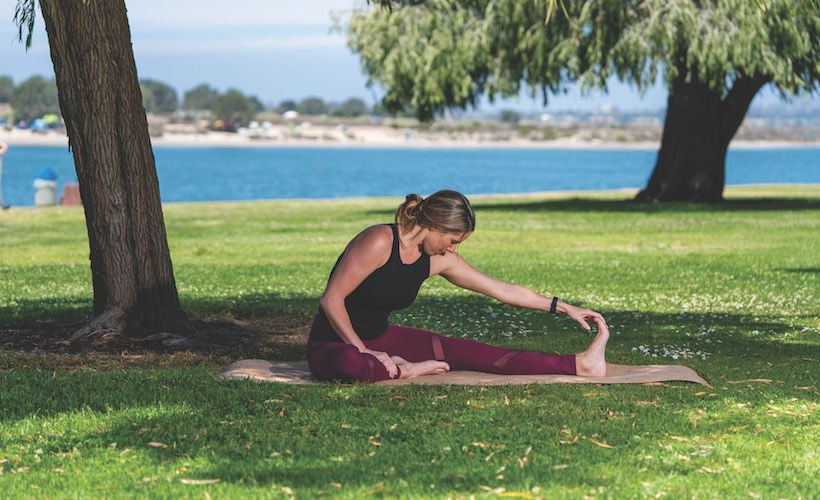
Do us a favor: Stand up right now and try to touch your fingers to your toes without bending your knees.
Can’t do it? That’s not necessarily a bad thing. Studies have shown that tightness in certain muscles and joints enables runners to stride more economically, using less oxygen to move at any given speed. This is just one of many recent discoveries that have led experts to question—and modify—traditional stretching practices in running.
If you’re like many runners, conflicting reports on the latest stretching science and methods have left you confused about what stretching does, whether or not you should do it, how to do it if you do and when. So we went straight to the experts to get answers you can rely on to run healthier and better.
What Does Stretching Do?
Any effort to spell out the facts about stretching needs to begin with a clear distinction between static and dynamic stretching. A static stretch entails holding a particular muscle group in a stretched position for 30 seconds or more (as in the classic toe touch), whereas a dynamic stretch entails stretching and relaxing a muscle group repeatedly.
According to Jay Dicharry, physical therapist and author of Running Rewired, these two types of stretches have very different purposes. “Static stretching is intended to increase soft-tissue length and thereby increase range of motion in the joint they connect to,” he says. Done in sufficient amounts over time, static stretching is proven to lengthen muscles and tendons and increase range of motion.
Dynamic stretching targets the nervous system. “Its purpose is to get the brain and the muscles communicating with each other in a way that prepares the body for activity by enabling runners to take advantage of the range of motion they already have,” Dicharry explains.
Should You Stretch?
In a recent review of existing research on the effects of stretching in runners, British and Australian scientists concluded that static stretching, although it does enhance flexibility, “poses no significant advantage to endurance runners,” in terms of performance or injury prevention. Does this mean you shouldn’t bother with static stretching? Not necessarily.
According to A.J. Gregg, a chiropractor and strength-and-conditioning specialist who works with elite and recreational runners at Hypo2 Sport in Flagstaff, Ariz., stretching can be beneficial—and even necessary—when range of motion in a particular joint is abnormally limited for some reason.
“For example, if your right hip flexor tightens up due to an injury and restricts your movement, you’ve got to work that stuff out before you run again,” he says.
In addition to the hip flexors, which allow your leg to extend behind your body when you run, two key areas where functional limitations commonly occur in runners are the ankles and the big toe. Simple tests can help you identify mobility deficiencies in each of these areas.
Even if your range of motion in one of these three areas is below normal, however, static stretching still may not be necessary. “‘Normal’ is different for each person,” explains Gregg, who adds that the thing to look out for is an imbalance between the left and right sides of your body. If your right ankle is less mobile than your left, for example, it’s a good idea to stretch the right one until the discrepancy disappears.
As for dynamic stretching, “That’s something I like to see every runner do,” Gregg says. “It’s a great way to get in tune with your body before you run, so that when you do run, your movements are more efficient and automatic.”
How Should You Stretch?
In 2011, Jay Dicharry coauthored a large study that investigated the effects of a rigorous stretching program on range of motion in men and women with tight hip flexors. His team found that 10 weeks of stretching the hip flexors for three to five minutes a day, five days per week, successfully restored normal mobility in subjects who lacked it initially.
These numbers now define the standard prescription for increasing joint mobility through stretching. If three to five minutes sounds like a long time to stretch—well, it is. But the good news is that you don’t have to do it all at once. Just be sure to hold each stretch for at least 30 seconds at a time, Dicharry says.
Dynamic stretching is less rule-bound. Dicharry suggests choosing one to three movements to do before you start your run—just enough to feel ready to go.
When Should You Stretch?
We’ve already seen that dynamic stretching is intended to be done before running. But do you need to do it before every run? “If you’re the kind of person who wakes up and runs before work,” Dicharry says, “or if you’ve been scrunched over a desk all day and then run after work, you should do something to open up your back and hips.” But if you’ve been active prior to starting your run, you should feel free to skip dynamic stretching, though it never hurts and is always a good idea, according to Dicharry, before high-intensity running.
Static stretching, on the other hand, can be done at any time except before running, as it temporarily reduces muscle power. Gregg notes that elite runners typically prefer to stretch after running, when the muscles are warm and pliable, and before bed, because it’s relaxing. But he cautions recreational runners who may not have time for everything to consider devoting these minutes to an activity that may be more beneficial.
“Unless you have a specific need to stretch, you’re probably better off spending that time on something like foam rolling or core strength work,” Gregg says.
Mobility Test For Runners
Use these three self-tests to determine if you have a mobility deficiency in the hips, ankles or big toes.
Hip Mobility Test
Get into a half-kneel position inside a doorframe with your right knee and left foot on the floor, your right thigh perfectly vertical and your midback touching the doorframe. Now tuck your tailbone and try to flatten your low back against the doorframe. If you feel a strong or uncomfortable stretch in the pocket area of your right thigh, you are deficient in hip extension mobility. Reverse your position and repeat this test on the left side.
Ankle Mobility Test
Sit in a chair with your feet flat on the floor and both knees bent 90 degrees. Slide forward in the chair until your knees pass just in front of your toes. If you can’t keep your heels on the floor, you are deficient in ankle dorsiflexion mobility.
Big Toe Mobility Test
Sit in a chair with your feet flat on the floor and both knees bent 90 degrees. Lift your right big toe as high as you can without allowing the ball of your foot to come off the floor. If you can’t raise it to an angle of 30 degrees, you are deficient in big toe dorsiflexion mobility. Now test your left big toe.
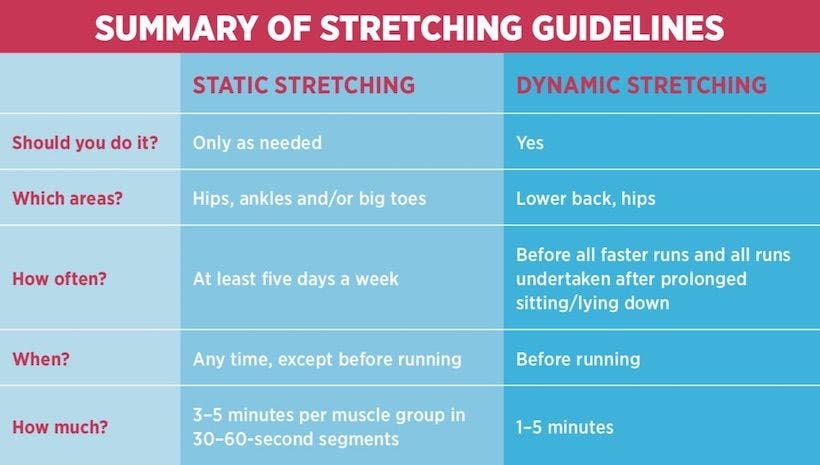
Static Stretches
Big Toe Stretch
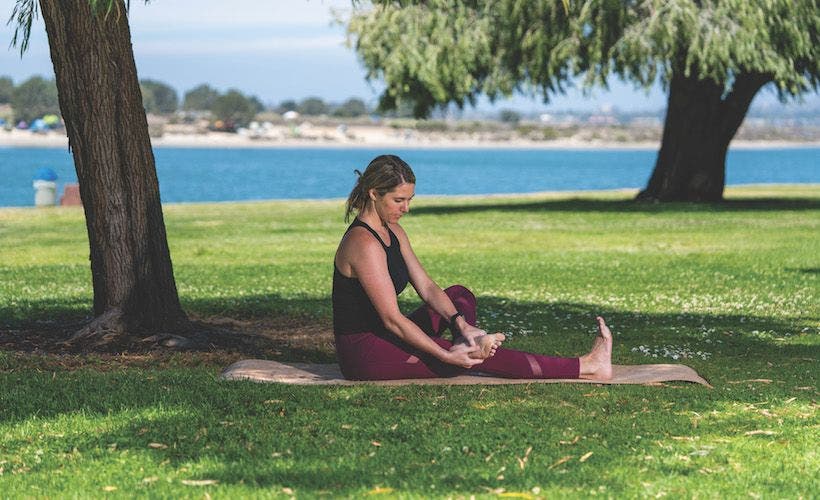
Restrictions in big toe mobility in runners are most often caused by tightness in the fascia on the bottom of the feet. To address this restriction, sit in a chair or on the ground with your right ankle crossed over your left knee and press your thumbs into the bottom of your foot. When you find sore spots, press and hold while slowly flexing and relaxing your toes. Now repeat with the left foot.
Calf Stretch
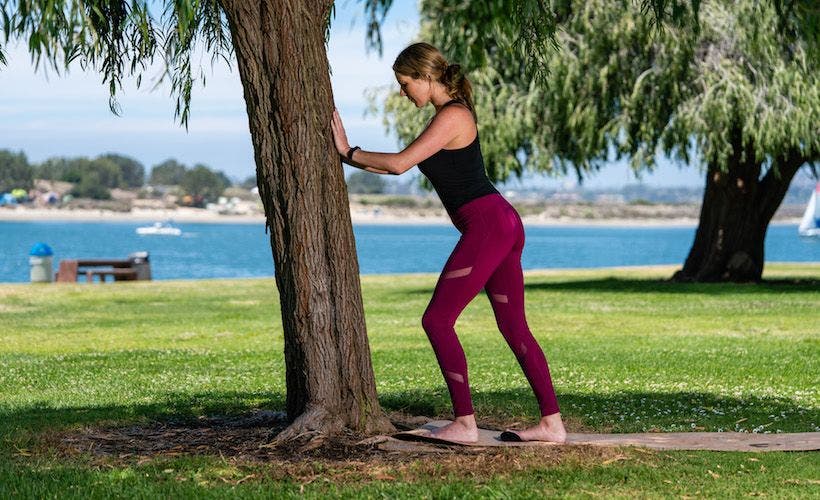
Stand facing a wall with your left foot a step ahead of the right and both feet flat on the floor with your right knee straight and your left knee slightly bent. Position a rolled-up towel under the arch of your right foot. Now lean forward, pressing your palms against the wall for balance, until you feel a good stretch in your right calf. Hold this position for 30 to 45 seconds and then bend the right knee slightly and hold for another 30 to 45 seconds. Finally, reverse your position to stretch the left calf.
Hip Flexor Stretch
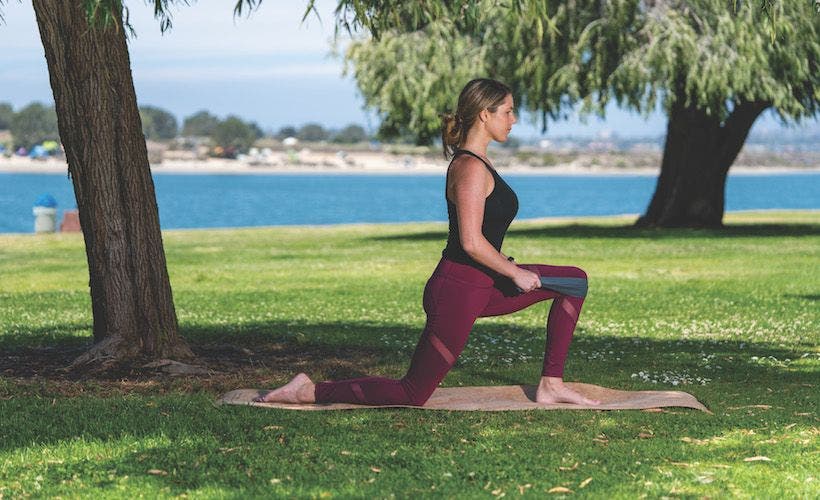
Get into a half-kneel position with your right knee and left foot on the floor and a 90-degree bend in both knees. Grab the ends of a short strap in your hands, loop it around your left knee and pull gently toward you. Keeping your torso upright, contract your glutes and press your hips forward until you feel a good stretch at the front of your right hip. Hold the stretch for 30 to 45 seconds and then reverse your position
and stretch the left hip.
Dynamic Warm-Up Stretch
Do this dynamic stretch before you start running as a way to prime your neuromuscular system for efficient, comfortable movement.
Twisting Warrior Stretch
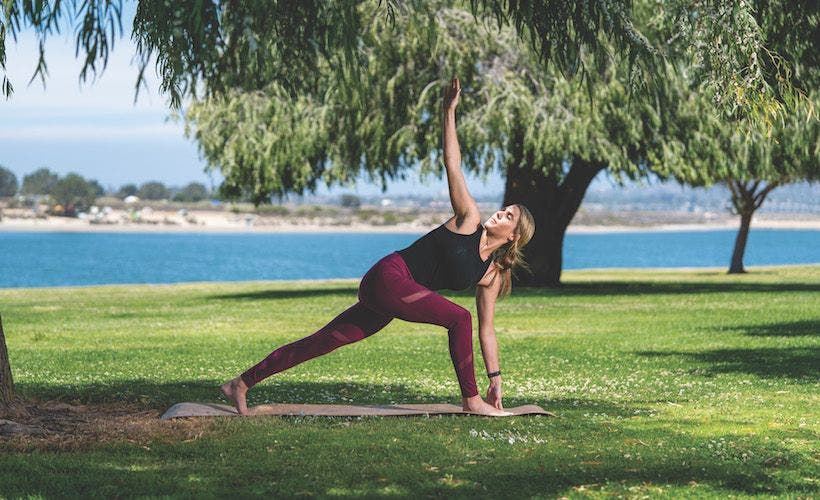
From a normal standing position, take a large step forward with your right foot, bending the right knee 90 degrees while keeping the left leg straight. Touch the fingertips of both hands to the ground just inside your right foot. Now twist your torso to the left and point your left arm straight upward, keeping the fingertips of your right hand on the ground and watching your left hand as you rotate. Next, reverse all of these movements and return to the start position. Complete five lunges with each leg, alternating sides.